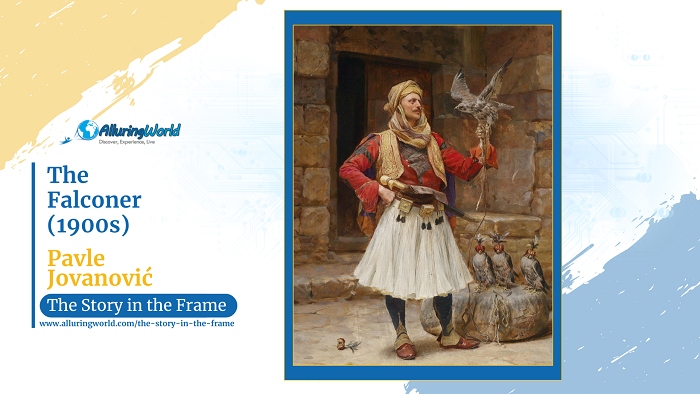The Falconer painted by Pavle Jovanović in the late 19th or early 20th century is a striking representation of a noble falconer that embodies themes of power, tradition, and the deep connection between humans and nature. As a part of Jovanović’s broader interest in historical and Orientalist subjects, this painting showcases his mastery of realism and attention to cultural details, so the artwork reflects not only his technical skill but also his fascination with the traditions of the Balkans and the East, making it a valuable piece in his collection of historical and genre scenes.
About the Painter:
Pavle “Paja” Jovanović (1859–1957) was one of Serbia’s most renowned realist painters, celebrated for his historical compositions, portraits, and depictions of Balkan life. He trained in Vienna and was influenced by European academic painting while maintaining a deep interest in the customs and traditions of his homeland, and his works often feature rich detail, dynamic movement, and an extraordinary ability to bring scenes to life. Throughout his career, Jovanović traveled extensively, gathering inspiration from different cultures and blending historical accuracy with artistic expression.
Inspiration and Reasons Behind the Painting:
Jovanović was inspired by historical themes and the grandeur of past eras, particularly those that showcased the customs and social structures of noble and military figures, so as falconry was a sport associated with aristocracy and the elite, it symbolized power, prestige, and discipline. Through The Falconer, Jovanović sought to capture the elegance and authority of a falconer, emphasizing the tradition of falconry as both an art and a symbol of status, and his fascination with Orientalist themes also played a role in shaping the painting, as falconry was historically practiced in the Balkans, the Middle East, and Central Asia.
What is Depicted in the Painting:
The painting portrays a falconer who is elegantly dressed in traditional attire, holding a falcon on his arm. The figure is set against a richly detailed background, possibly hinting at a noble setting or an expansive landscape. The falcon that is a symbol of strength, precision, and nobility, is poised, ready for flight, reflecting the disciplined nature of both bird and handler. The falconer’s expression conveys confidence and control, reinforcing the idea of mastery over nature, and the intricate detailing of his garments, the falcon’s feathers, and the surrounding environment showcase Jovanović’s skill in rendering texture and depth with remarkable precision.
Colors and Techniques:
Jovanović’s palette in The Falconer is rich and vibrant, dominated by deep earthy tones, luxurious reds, and golds that highlight the opulence of the falconer’s attire. The contrast between light and shadow adds depth to the painting, creating a lifelike representation of fabric, skin, and the falcon’s feathers. His brushwork is both precise and fluid, capturing the dynamic posture of the falconer and the fine details of his environment. The careful composition guides the viewer’s eye to the central figure while allowing the surrounding elements to enhance the story being told.
Conclusion:
In conclusion, The Falconer is a testament to Pavle Jovanović’s ability to combine historical accuracy with artistic expression, and as the painting stands as an elegant portrayal of nobility, tradition, and the deep relationship between humans and nature. Today, it remains a celebrated work within his collection, admired for its technical brilliance and its ability to transport viewers into a world of history, power, and refinement.

